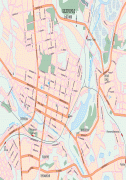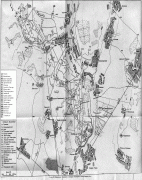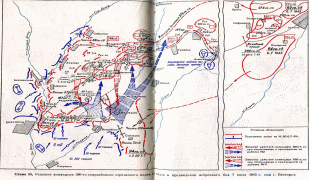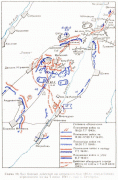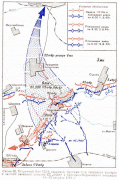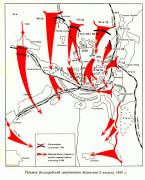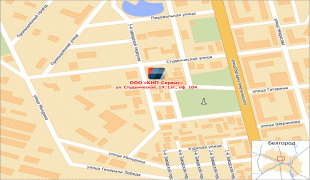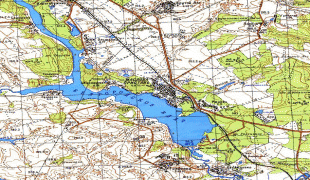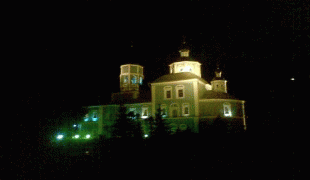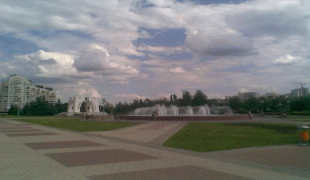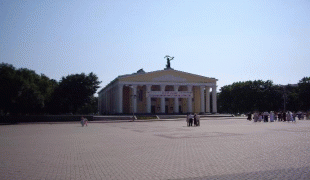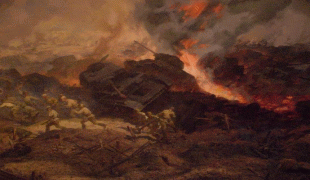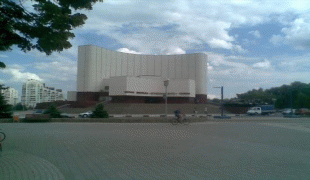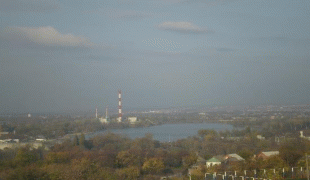Earth
Earth is the third planet from the Sun and home to all known life. While large volumes of water can be found throughout the Solar System, only Earth sustains liquid surface water. Approximately 70.8% of Earth's surface is made up of the ocean, dwarfing Earth's polar ice, lakes, and rivers. The remaining 29.2% of Earth's surface is land, consisting of continents and islands. Earth's surface layer is formed of several slowly moving tectonic plates, which interact to produce mountain ranges, volcanoes, and earthquakes. Earth's liquid outer core generates the magnetic field that shapes the magnetosphere of Earth, deflecting destructive solar winds.
The atmosphere of Earth consists mostly of nitrogen and oxygen. Greenhouse gases in the atmosphere like carbon dioxide (CO2) trap a part of the energy from the Sun close to the surface. Water vapor is widely present in the atmosphere and forms clouds that cover most of the planet. More solar energy is received by tropical regions than polar regions and is redistributed by atmospheric and ocean circulation. A region's climate is governed not only by latitude but also by elevation and proximity to moderating oceans. In most areas, severe weather, such as tropical cyclones, thunderstorms, and heat waves, occurs and greatly impacts life.
Earth is an ellipsoid with a circumference of about 40,000 km. It is the densest planet in the Solar System. Of the four rocky planets, it is the largest and most massive. Earth is about eight light-minutes away from the Sun and orbits it, taking a year (about 365.25 days) to complete one revolution. The Earth rotates around its own axis in slightly less than a day (in about 23 hours and 56 minutes). The Earth's axis of rotation is tilted with respect to the perpendicular to its orbital plane around the Sun, producing seasons. Earth is orbited by one permanent natural satellite, the Moon, which orbits Earth at 380,000 km (1.3 light seconds) and is roughly a quarter as wide as Earth. Through tidal locking, the Moon always faces the Earth with the same side, which causes tides, stabilizes Earth's axis, and gradually slows its rotation.
Earth, like most other bodies in the Solar System, formed 4.5 billion years ago from gas in the early Solar System. During the first billion years of Earth's history, the ocean formed and then life developed within it. Life spread globally and began to affect Earth's atmosphere and surface, leading to the Great Oxidation Event two billion years ago. Humans emerged 300,000 years ago, and have reached a population of 8 billion today. Humans depend on Earth's biosphere and natural resources for their survival, but have increasingly impacted the planet's environment. Today, humanity's impact on Earth's climate, soils, waters, and ecosystems is unsustainable, threatening people's lives and causing widespread extinctions of other life.
The Modern English word Earth developed, via Middle English, from an Old English noun most often spelled . It has cognates in every Germanic language, and their ancestral root has been reconstructed as *erþō. In its earliest attestation, the word eorðe was already being used to translate the many senses of Latin and Greek gē: the ground, its soil, dry land, the human world, the surface of the world (including the sea), and the globe itself. As with Roman Terra/Tellūs and Greek Gaia, Earth may have been a personified goddess in Germanic paganism: late Norse mythology included Jörð ('Earth'), a giantess often given as the mother of Thor.
Historically, earth has been written in lowercase. From early Middle English, its definite sense as "the globe" was expressed as the earth. By the era of Early Modern English, capitalization of nouns began to prevail, and the earth was also written the Earth, particularly when referenced along with other heavenly bodies. More recently, the name is sometimes simply given as Earth, by analogy with the names of the other planets, though earth and forms with the remain common. House styles now vary: Oxford spelling recognizes the lowercase form as the most common, with the capitalized form an acceptable variant. Another convention capitalizes "Earth" when appearing as a name (for example, "Earth's atmosphere") but writes it in lowercase when preceded by the (for example, "the atmosphere of the earth"). It almost always appears in lowercase in colloquial expressions such as "what on earth are you doing?"
Occasionally, the name Terra is used in scientific writing and especially in science fiction to distinguish humanity's inhabited planet from others, while in poetry Tellus has been used to denote personification of the Earth. Terra is also the name of the planet in some Romance languages (languages that evolved from Latin) like Italian and Portuguese, while in other Romance languages the word gave rise to names with slightly altered spellings (like the Spanish Tierra and the French Terre). The Latinate form Gæa or Gaea of the Greek poetic name Gaia (Γαῖα; or ) is rare, though the alternative spelling Gaia has become common due to the Gaia hypothesis, in which case its pronunciation is rather than the more classical English.
There are a number of adjectives for the planet Earth. From Earth itself comes earthly. From the Latin Terra comes terran, terrestrial , and (via French) terrene , and from the Latin Tellus comes tellurian and telluric.
The atmosphere of Earth consists mostly of nitrogen and oxygen. Greenhouse gases in the atmosphere like carbon dioxide (CO2) trap a part of the energy from the Sun close to the surface. Water vapor is widely present in the atmosphere and forms clouds that cover most of the planet. More solar energy is received by tropical regions than polar regions and is redistributed by atmospheric and ocean circulation. A region's climate is governed not only by latitude but also by elevation and proximity to moderating oceans. In most areas, severe weather, such as tropical cyclones, thunderstorms, and heat waves, occurs and greatly impacts life.
Earth is an ellipsoid with a circumference of about 40,000 km. It is the densest planet in the Solar System. Of the four rocky planets, it is the largest and most massive. Earth is about eight light-minutes away from the Sun and orbits it, taking a year (about 365.25 days) to complete one revolution. The Earth rotates around its own axis in slightly less than a day (in about 23 hours and 56 minutes). The Earth's axis of rotation is tilted with respect to the perpendicular to its orbital plane around the Sun, producing seasons. Earth is orbited by one permanent natural satellite, the Moon, which orbits Earth at 380,000 km (1.3 light seconds) and is roughly a quarter as wide as Earth. Through tidal locking, the Moon always faces the Earth with the same side, which causes tides, stabilizes Earth's axis, and gradually slows its rotation.
Earth, like most other bodies in the Solar System, formed 4.5 billion years ago from gas in the early Solar System. During the first billion years of Earth's history, the ocean formed and then life developed within it. Life spread globally and began to affect Earth's atmosphere and surface, leading to the Great Oxidation Event two billion years ago. Humans emerged 300,000 years ago, and have reached a population of 8 billion today. Humans depend on Earth's biosphere and natural resources for their survival, but have increasingly impacted the planet's environment. Today, humanity's impact on Earth's climate, soils, waters, and ecosystems is unsustainable, threatening people's lives and causing widespread extinctions of other life.
The Modern English word Earth developed, via Middle English, from an Old English noun most often spelled . It has cognates in every Germanic language, and their ancestral root has been reconstructed as *erþō. In its earliest attestation, the word eorðe was already being used to translate the many senses of Latin and Greek gē: the ground, its soil, dry land, the human world, the surface of the world (including the sea), and the globe itself. As with Roman Terra/Tellūs and Greek Gaia, Earth may have been a personified goddess in Germanic paganism: late Norse mythology included Jörð ('Earth'), a giantess often given as the mother of Thor.
Historically, earth has been written in lowercase. From early Middle English, its definite sense as "the globe" was expressed as the earth. By the era of Early Modern English, capitalization of nouns began to prevail, and the earth was also written the Earth, particularly when referenced along with other heavenly bodies. More recently, the name is sometimes simply given as Earth, by analogy with the names of the other planets, though earth and forms with the remain common. House styles now vary: Oxford spelling recognizes the lowercase form as the most common, with the capitalized form an acceptable variant. Another convention capitalizes "Earth" when appearing as a name (for example, "Earth's atmosphere") but writes it in lowercase when preceded by the (for example, "the atmosphere of the earth"). It almost always appears in lowercase in colloquial expressions such as "what on earth are you doing?"
Occasionally, the name Terra is used in scientific writing and especially in science fiction to distinguish humanity's inhabited planet from others, while in poetry Tellus has been used to denote personification of the Earth. Terra is also the name of the planet in some Romance languages (languages that evolved from Latin) like Italian and Portuguese, while in other Romance languages the word gave rise to names with slightly altered spellings (like the Spanish Tierra and the French Terre). The Latinate form Gæa or Gaea of the Greek poetic name Gaia (Γαῖα; or ) is rare, though the alternative spelling Gaia has become common due to the Gaia hypothesis, in which case its pronunciation is rather than the more classical English.
There are a number of adjectives for the planet Earth. From Earth itself comes earthly. From the Latin Terra comes terran, terrestrial , and (via French) terrene , and from the Latin Tellus comes tellurian and telluric.
Map - Earth
Map
Country - Russia
 |
 |
| Flag of Russia | |
The East Slavs emerged as a recognisable group in Europe between the 3rd and 8th centuries CE. The first East Slavic state, Kievan Rus', arose in the 9th century, and in 988, it adopted Orthodox Christianity from the Byzantine Empire. Rus' ultimately disintegrated, with the Grand Duchy of Moscow growing to become the Tsardom of Russia. By the early 18th century, Russia had vastly expanded through conquest, annexation, and the efforts of Russian explorers, developing into the Russian Empire, which remains the third-largest empire in history. However, with the Russian Revolution in 1917, Russia's monarchic rule was abolished and replaced by the Russian SFSR—the world's first constitutionally socialist state. Following the Russian Civil War, the Russian SFSR established the Soviet Union (with three other Soviet republics), within which it was the largest and principal constituent. At the expense of millions of lives, the Soviet Union underwent rapid industrialization in the 1930s, and later played a decisive role for the Allies of World War II by leading large-scale efforts on the Eastern Front. With the onset of the Cold War, it competed with the United States for global ideological influence; the Soviet era of the 20th century saw some of the most significant Russian technological achievements, including the first human-made satellite and the first human expedition into outer space.
Currency / Language
| ISO | Currency | Symbol | Significant figures |
|---|---|---|---|
| RUB | Russian ruble | ₽ | 2 |
| ISO | Language |
|---|---|
| CE | Chechen language |
| CV | Chuvash language |
| KV | Komi language |
| RU | Russian language |
| TT | Tatar language |






